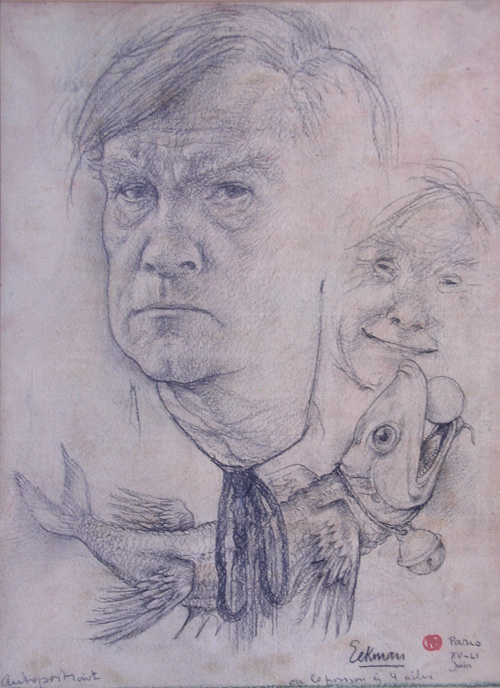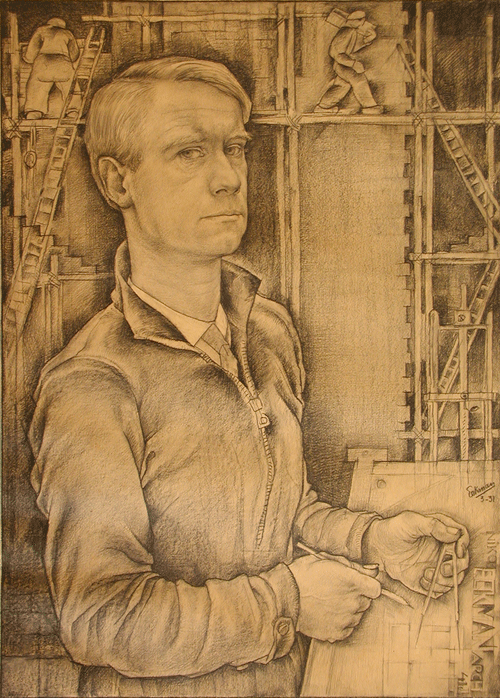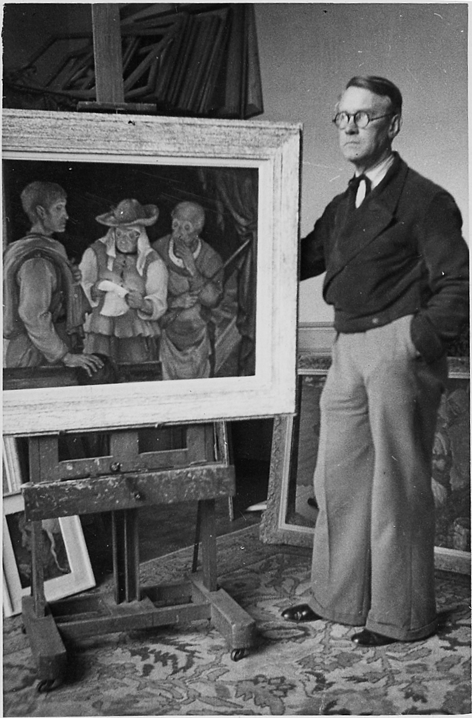Eekman by Eekman (interwiew)
I was born on the Place of Barricades, No. 4, in Brussels in the house and room where Victor Hugo wrote some of his Miserables. Myself, I am one of his results : "a little miserable". I do not know if this has something to do with painting or not but in any case it is a start quite amusing to see.
Then I did studies of architecture and everything started from there, from the famous Place of Barricades.
Self-portrait or four wing fish, 1951, pencil drawing, 17.7 x 12.5 in
In the house of Van Gogh.
The war had began, I had to flee Belgium, I arrived in Holland. And I found there, my little corner of Nuenen, a little corner of history. I was received there by a friend, the Pastor of Ligt who lived in the presbytery where used to live Van Gogh. He said: "Nic, you're a painter, you must come where Van Gogh lived, come and stay with me in the rectory". I lived for four years in Van Gogh’s house, in Van Gogh’s room, and I lived with his models, with people he had known. I have stories that are completely unheard of these models, these weavers that I met, that I drew, with whom I worked, came to tell me surrealistic stories about him. So it gave me a boost and, naturally, my respect for Van Gogh had only grown. Nobody knew him yet.
I saw at peasants homes Van Gogh’s paintings above their beds. It is now worth millions, but I saw that, I remember those days ...
I lived life with simple people, farmers in Brabant, with Van Gogh’s former girlfriend. I lived with her -so to speak- I used to talk with her, I went to her house, I drank coffee at the table where Van Gogh had painted the "Coffee Drinkers", at the same table, I saw all those people there. I know them. All that has become for me a handy paste, fantastic paste that I could peel, eat, I could feed myself. It was beautiful.
Self-portrait or The Architect, 1931, pencil drawing, 29.5 x 21.2 inches
Eekman the "Flemish"
My father was Dutch from Flushing and my mother from Gouda. So, two Dutch came to Brussels. I was born in this Dutch family and my father is from Flushing, I think it is almost Flemish. At the border. Same sky, same water, same delta, same grass... So I probably have a Flemish background as Mr. Sadi de Gorter, the cultural adviser of the Netherlands in Paris, said in one of his little writings: "Mr. Eekman is a Flandrian."
So, he expresses my Flanders side, while not Flemish, Flemish... you understand? For Flanders goes very far in France. We can even say it joins Paris.
De La Tour, Watteau were Flemish. Vlaminck too, of course. That’s why I am somewhat a patchwork across it, because there are influences from everywhere.
The egg man
If there is an egg Paris-Amsterdam-Basel-London, it makes a circular motion, an egg, a European egg, I call it. And it is there that we see all these great artists. This motion is very strange.
So I like to say that I am the egg man, or, if you want, the man in the bud! And perhaps that's why the oval motion is very, very frequent: the round or oval apple, because even when it is round, it becomes oval because I put that in perspective.
It's very curious. The circle and ovum are for me elements which may be esoteric, perhaps even philosophical too.
N. Eekman in his workshop in 1943
Mondrian's friend
When I was in Paris in the early years, I was in contact with Mondrian. He was a great friend, a very, very good friend who had almost no friends.
For an architect, it was good to see Mondrian. Ah yes, it was very interesting. There were some influences that I could tolerate as I had studied architecture. It was not a weird thing after all. It was not out of my interest, it was my point, because I was already searching for the line. In Mondrian’s works, I saw the absolutism of this line that I counteracted as I could because the absolute can not exist in our world, we are still in a precarious situation, there is not to say.
So I accepted Mondrian. We have had extensive conversations on this. To me, he always said: "I am not a painter, I am a theosophist", because all his paintings are reduced to writings. He wrote thick books but nobody has ever wanted to publish them because people thought : this is not painting, and then we lose our painter. So, we remain silent. But I know that Mondrian did not want to be a painter, he was not a painter, but a theosophist who used the line and colors to express his theosophical ideas.
Painting human ethics and aesthetics
I almost always work in a kind of great moral obligation because I feel that I must. There are things I cannot not do. I stand before a canvas, I begin to scratch something, a few confused lines because I start with abstraction. I wait for the radiations from the cosmos while I paint the human being.
And I must not get into the moon, with the cosmos with all its cosmic elements that disintegrate me. I must be down to earth, and that is what I am striving to. No, no. Having succeeded or failed, I do not have to answer for anything, and I do not even have to ask: "Is this good or not?" It is none of your business. What I mean is that I am compelled to do so, take it or leave it. But what I do, I do so in good conscience, but so that I can not deny it.
Excerpts of the interview for the Belgian newspaper "Candide" in 1965.






